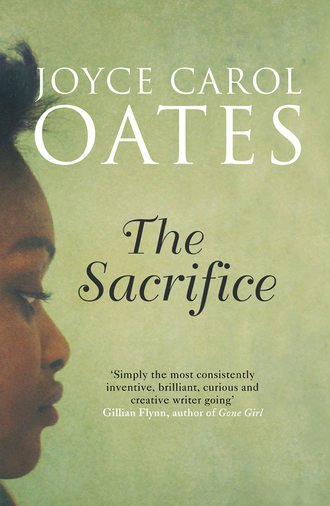
Полная версия
The Sacrifice
It was possible, I thought, she was—you know—mentally disabled like retarded, or autistic. She communicated with me …
She did not communicate with you. She was not observed communicating with you.
She didn’t talk to me exactly but, but she—communicated …
Look—this was not a “cooperative” individual. First thing when we came down into the cellar with flashlights we saw the girl’s eyes were open and she’s staring at us—then, she shut her eyes. We saw her lifting her hands to hide her face from the bright light—which you wouldn’t do if you were unconscious.
The lights blinded her and scared her …
Had a damn hard time taking her blood pressure and pulse and trying to check for injuries, she kept bending her legs and wouldn’t lay them flat so we could strap her down.
Sometimes it happens, an injured person is panicked and doesn’t want to be taken to the ER.
But this girl refused to talk to us. She wasn’t screaming or saying she didn’t want medical treatment. She wasn’t hysterical or crazy. She was trying to simulate being unconscious but she was awake and alert. You could see her eyeballs kind of jerking around behind her eyelids. You could see she’d been assaulted, a strong possibility she’d been raped, her clothes were torn partly off except she was still wearing jeans—bloodied jeans.
The visible injuries were lacerations and bruises on her face, her chest, her belly—where her clothes had been ripped, you could see.
The woman had been screaming the girl was “bleeding to death” but that was not the case.
Most of the blood appeared to be dried, coagulated. Whenever she’d been beaten, it hadn’t been recently.
She’d been beaten and left to die! Tied and a gag in her mouth and left to die in that nasty place! When we found her, she was in a state of shock.
Actually she was not in a “state of shock”—her blood pressure wasn’t low, we discovered when we were finally able to take it, and her pulse was fast.
She was in, like, emotional shock …
The woman was explaining she’d been wakened by “some kind of crying” in the night then in the morning she’d searched outside and found the girl tied and bleeding and left to die and she was worried since she’d moved the girl a little, started to lift her off the tarpaulin, maybe the girl had a skull fracture or broken spine or internal injuries she might’ve made worse, she wanted to tell us that.
The woman was kind of hysterical herself. She looked like her heart was jumping all over inside her chest. Said she was a schoolteacher and the girl had been one of her pupils …
Kept saying she’d thought the girl had been thrown down from some height, and her back was broken. She’d thought the girl was bleeding to death, that’s what she’d told us when we first arrived. And the girl had been raped, she was sure of that …
She’d wanted to come in the ambulance with us but we had to tell her no. We told her to notify the girl’s mother.
That poor girl was in a state like panic. Maybe it wasn’t “shock” but she was panting—hyperventilating. Her skin was clammy like death.
Well—anybody would be scared and upset, in her circumstances. With just the flashlights we could see it had been a vicious attack. And you’d think for sure, rape. The disgusting thing was what was smeared in her hair and on the parts of her body that had been naked—mud and dog shit. And in the ambulance we saw something spelled out on her body.
These nasty words! Smeared in dog shit on that poor girl.
It wasn’t dog shit the words were written in, it was some kind of smeared ink like a marker pen.
It was dog shit, too. I saw it.
The scrawled words were in black marker pen. It was hard to make out what they were because the ink was smeared, and the girl’s skin was kind of dark …
The thing is, if you are unconscious, your limbs are not stiff and you don’t resist medical intervention. If you are conscious, you might resist—if you are terrified and panicked. But we got a blood pressure reading finally and she wasn’t in shock—or anywhere near—her pressure was 130 over 115. Her pulse was fast but not racing.
You could see that somebody had hurt her bad! There’d been more than one of them, they’d kicked her and cut her and left her to die in that nasty place.
In the ER in the bright lights you could see these words scrawled on her chest and belly you couldn’t read too well because the letters were smeared and distorted NIGRA BITCH KU KUX KLANN.
(Right away I had to wonder—why’d anybody write words on somebody’s body upside-down?)
NIGRA BITCH—this was just below the girl’s breasts, on her midriff.
KU KUX KLANN—this was on the girl’s belly just above her navel.
Photos were taken of these racist words as photos were taken of the girl’s injuries. This is ER procedure in such cases. When the flashes went off Sybilla Frye tried to hide her face making a wailing sound like Noooo.
It was our assumption she’d been raped—very possibly, gang-raped. Her clothes were ripped and bloody and her lower belly and thighs were bruised, we saw when we got the jeans pulled down. (She fought us pretty desperately about that—pulling down her jeans.) Her face had sustained the worst injuries. Both her eyes were blackened and her upper lip was swollen to twice its size, like a goiter.
A brutal gang-rape is not a common incident even in inner-city Pascayne. Yet, a brutal gang-rape is not an uncommon incident in inner-city Pascayne.
When she was first brought in Sybilla Frye hadn’t been ID’d yet. We didn’t know her name or address or who to contact. The EMTs couldn’t help us much. We were asking her questions but she kept pretending to be unconscious and unable to hear us when it was obvious that she was conscious and she was hearing us.
I was the ER physician on duty, Sunday morning October 7.
Right away I said to her, “Miss? Open your eyes, please.” Because I had to examine her eyes. I had to determine if possibly she’d had a concussion or a skull fracture. I’d be ordering X-rays including X-rays of her skull. But still she wouldn’t open her eyes. She was so tense, you could feel her body quivering. Yet she refused to cooperate. She pretended to be unconscious the way a small child might pretend to be “asleep.” It isn’t easy to pretend you’re unconscious when you’re conscious. You might think it is, but it isn’t. I lifted one of her arms over her head and released it and immediately she deflected her arm to avoid striking her face—it’s a reflex you can’t help. Clearly, this girl who’d be identified as “Sybilla Frye” was conscious in the ER and in control of her reactions. I could see she’d been injured—that was legitimate—I felt sorry for her but this kind of uncooperative behavior would impede us in our treatment so I said, “Miss, you can hear me. So open your eyes”—and finally she did.
Looked at Dr. D___, like she was terrified of him.
Dr. D___ is Asian, light-skin. Later it came out she was afraid of him, he’d looked “white” to her.
Of the EMTs, just one of us was “white”—“white Hispanic.” The others were dark-Hispanic, African-American. Yet, she’d acted scared of us.
She was terrified! Just so scared …
She wasn’t hysterical but she was—she wasn’t—you had to concur she wasn’t in her right mind and under these circumstances you couldn’t blame her for not cooperating. She didn’t seem to understand where she was, or what was happening …
She understood exactly where she was, and exactly what was happening. She didn’t wish to cooperate, that’s all.
I did wonder why she wasn’t crying—most girls would’ve been crying by now. Most women.
We treated her for face wounds. Lacerations, black eyes, mashed nose, bloody lip. A couple of loosened teeth where he’d punched her. (You could almost see the imprint of a man’s fist in her jaw. But he hadn’t strangled her, there were no red marks around her throat.) The blood wasn’t fresh but had coagulated in her nostrils, in her hair, etc. By their discolorations you could see that the bruises were at least twenty-four hours old. Also the blackened eyes. We gave her stitches for the deepest cuts in her eyebrow and on her upper lip. She reacted to the stitches and disinfectant so we had to hold her down but she still didn’t say any actual words only just Noooo. We wondered if she was, like, a Dominican who didn’t know English, or—there’s Nigerians in Pascayne—maybe she was Nigerian …
There were Hispanic nurses we called in, to try to talk to her in Spanish—she ignored them completely.
Where (presumably) the rope had been tied around her wrists and ankles there were only faint red abrasions on the skin. No deep abrasions, welts, or cuts.
We couldn’t get a blood sample. That wasn’t going to happen just yet.
Pascayne police officers were just arriving at the factory when the EMTs bore the girl away in the ambulance. The bloodied tarpaulin and other items were left there for the police to examine and take away as evidence.
Soon then, police officers began to arrive at St. Anne’s ER.
The hard part was—the pelvic exam …
We had to determine if she’d been raped. Had to take semen samples if we could. Any kind of evidence like pubic hairs, we had to gather for a rape kit, but the girl was becoming hysterical, not pretending but genuinely hysterical kicking and screaming No no don’t hurt me NO! Dr. D___ was angry that the girl seemed determined to prevent a thorough examination though such an examination was in her own best interests of course. We were able to examine her and treat her superficially and it took quite a while to accomplish that with her kicking, screaming, and hyperventilating and the orderlies having to hold her down …
(Now we knew, at least—she could speak English.)
She continued to refuse to allow Dr. D___ to examine her just clamped her legs together tight and screaming so Dr. D___—(flush-faced, upset)—asked one of the female interns to examine her; this young woman, Dr. T___, was a light-skinned Indian-American who was able to calm the girl to a degree and examined her pelvic area by placing a paper cover over the girl’s lower body but when Dr. T___ tried to insert a speculum into the girl’s vagina the girl went crazy again kicking and screaming like she was being murdered.
Like she was being raped …
It was a terrible thing to witness. Those of us who were there, some of us were very upset with Dr. D___’s handling of the situation.
By this time, the mother had arrived. The mother had been notified and someone had driven her to the hospital and before security could stop her she’d run into the ER hearing her daughter’s screams and began screaming herself and behind her, several other female relatives, or neighbors—all these women screaming and our security officers overwhelmed trying to control the scene …
Pascayne police arrived at the ER. Trying to ask questions and the girl refused to acknowledge anyone shutting her eyes tight and screaming she wanted to go home and the mother was saying My baby! My baby! What did they do to my baby!
You couldn’t get near the girl without her screaming, kicking and clawing. We’d have sedated her but the mother was threatening to sue us if we didn’t release her daughter.
(It is strange that a mother would want her daughter released into her custody out of the ER, before she knew the extent of her daughter’s injuries. It is strange that the mother, like the daughter, refused X-rays, a blood test, but it is not so very uncommon under these circumstances. We are accustomed to delusional behavior and violence in the ER. We are accustomed to patients dying in the ER and their relatives going berserk. Yet, this seemed like a special case.)
We were trying to explain: the girl had to have X-rays before being discharged.
It was crucial, the girl had to have X-rays.
If she’d suffered a concussion, or had a hairline fracture in her skull, or had broken or sprained bones—it was crucial to determine this before she left the hospital.
If there was bleeding in her brain, for instance.
And we needed to do blood work. We needed to draw blood.
Mrs. Frye didn’t give a damn for any of this. In a furious voice saying how her daughter had been missing three days and three nights and wherever she’d been there were people who knew more than they were revealing and she’d come to take her daughter home, now.
They took my baby from me, now I’m bringin my baby home can’t none of you stop me.
The Pascayne police officers set her off worse. When an officer from Child Protective Services tried to speak with Mrs. Frye she backed off stretching her arms out as if to keep the man from assaulting her. She was saying You aint gon arrest me, you aint gon put cuffs on me, you leave me alone seein what you done to my baby aint that enough for you.
Mrs. Frye’s fear of the police officers appeared to be genuine.
By this time Sybilla Frye was sitting up on the gurney with her knees raised against her chest trying to hide herself with the crinkly white paper and making a noise like Nnn-nnn-nnn—like she was so frightened, she was shivering convulsively. You could hear her teeth chatter. And now she was crying, like a child Mama don let them take me, Mama take me home …
The mud and dog-feces had been removed from the girl’s hair.
We’d had to cut and clip some of her hair in order to get this matter out. It would be charged afterward that we had defiled and disfigured Sybilla Frye—we had deliberately cut her hair in a careless and jagged fashion.
Her body covered in filth had been washed but the racist slurs in black Magic Marker ink remained on her torso and abdomen, more or less indecipherable.
(It would be recorded in the ER photos that these words had been written upside-down on Sybilla Frye’s body.)
(Well, you’d think—as if Sybilla Frye had written the words herself, right? But a clever assailant might’ve written the words on her body standing behind her so that she could read the words. Or—he’d written the words upside-down purposefully so the victim would be accused of lying. That was possible.)
(Seeing the racist words on the girl’s body we’d had to notify the FBI right then. This is protocol if there is a probable “hate crime” as there certainly was in this case.)
In an emergency unit in a city like Pascayne, New Jersey, you are half the time reporting crimes and taking such photos for forensic use. If your patient dies, you may be the only witnesses.
The FBI had to be notified immediately which the ER administrator did without either the injured girl or her mother knowing at the time.
Mrs. Frye was demanding to speak with her daughter “in private” if we wouldn’t release the girl so she could take her home. Dr. D___ allowed this.
Mrs. Frye jerked the curtain shut around the cubicle.
For some minutes, Mrs. Frye and Sybilla whispered together.
Police officers were asking the ER staff and the EMTs what had happened and we told them what we knew: Mrs. Frye had ID’d her daughter who was “Sybilla Frye”—“fourteen years old”—(in fact, it would be revealed later that Sybilla Frye was actually fifteen: she’d been born in September 1972); the girl had been assaulted and had sustained a number of injuries; she’d been struck by fists and kicked, but she didn’t seem to have been attacked with any weapons; cuts in her face had been made with a fist or fists, not a sharp instrument; there were no gunshot wounds; her face, torso, belly, legs and thighs were bruised, and there appeared to be evidence of bruising in the vaginal area, but without a pelvic exam it wasn’t possible to determine if there had been sexual penetration or any deposit of semen.
Skin samples taken from the girl’s body would be tested for DNA and these might contain semen. Other tests would be run, to determine if a sexual offense had been committed.
Mrs. Frye had claimed that her daughter had been “kidnapped” and “locked up” somewhere for three days and three nights. During this time, Mrs. Frye had been looking for the girl “everywhere she knew” but no one had seen her. Then, that morning, Sybilla Frye had been discovered by a woman who lived near the Jersey Foods factory, who’d heard the girl “crying and moaning” in the night.
So far, Sybilla Frye had not identified nor even described her assailant or assailants. She had not communicated with the ER staff at all.
She had not allowed a pelvic exam, nor had she consented to a blood test.
Despite the mother’s claim that she’d been kept captive somewhere for three days, Sybilla Frye did not appear malnourished or dehydrated.
This is some of what we told Pascayne police.
After approximately ten minutes of whispered consultation, Mrs. Frye drew back the curtain. She was deeply moved; her face was bright with tears. She’d been wiping her daughter’s face with tissues and now she was demanding that she be allowed to take her daughter home, it was a “free country” and unless they was arrested she was taking S’billa home.
(Ednetta Frye would afterward claim that she’d had to clean her daughter of mud and dog shit herself, the ER staff had not “touched a cloth” to Sybilla. She would claim that she’d carried her baby in her arms out of the ER, filth still in the girl’s hair and on her body, and her body naked, covered in only a “nasty” blanket as the ER staff had cut off her clothes for “evidence.”)
An officer from Juvenile Aid had arrived. But Mrs. Frye refused to allow Sybilla to speak to this woman, as she’d refused to allow Sybilla to speak to the officer from Child Protective Services.
It was explained to Mrs. Frye that since a crime or crimes had been committed, Sybilla would have to be interviewed by police officers—she would have to give a “statement”—when she was well enough … Mrs. Frye said indignantly That girl aint gon be “well enough” for a long time so you just let her alone right now. I’m warnin you—let my baby an me alone, we gon home right now or I’m gon sue this hospital an every one of you for kidnap and false imprisonment.
But finally Mrs. Frye relented, saying she would allow Sybilla to talk to a cop—One of her own kind, and a woman—if you have one in that Pas’cyne PD.
The Interview
It was not an ideal interview. It did not last beyond twenty stammered minutes.
It would be the most frustrating interview of her career as a police officer.
She’d been bluntly told that a black girl beaten and (possibly) gang-raped had requested a black woman police officer to interview her at the St. Anne’s ER.
Getting the summons at her desk in the precinct station late Sunday morning she’d said, D’you think I’m black enough, sir?—in such a droll-rueful way her commanding officer couldn’t take offense.
She couldn’t take offense, she understood the circumstances.
She was not minority hiring. She didn’t think so.
She’d been on the Pascayne police force for eleven years. She had a degree from Passaic State College and extra credits in criminology and statistics as well as her police training at the New Jersey Academy. She was thirty-six years old, recently promoted to detective in the Pascayne PD.
As a newly promoted detective she worked with an older detective on most cases. This would be an exception.
Iglesias did not check black when filling out appropriate official forms. Iglesias did not think of herself as a person of color though she acknowledged, seeing herself in reflective surfaces beside those colleagues of hers who were white, that she might’ve been, to the superficial eye, a light-skinned Hispanic.
Her (Puerto Rican–American) mother wasn’t her biological mother. Her (African-American) father wasn’t her biological father. Where they’d adopted her, a Catholic agency in Newark, there was a preponderance of African-American babies, many “crack” and “HIV” babies, and Iglesias did not associate herself with these, either. Her (adoptive) grandparents were a mix of skin-colors, a mix of racial identities—Puerto Rican, Creole, Hispanic, Asian, African-American and “Caucasian.” There was invariably a claim of Native-American blood—a distant strain of Lenape Indians, on Iglesias’s father’s side. The Iglesias family owned property in the northeast sector of Pascayne adjacent to the old, predominantly white sector called Forest Park; they owned rental properties and several small stores as well as their own homes. It was not uncommon for a young person in Iglesias’s family to go to college—Rutgers-Newark, Rutgers–New Brunswick, Bloomfield College, Passaic State. The most talented so far had had a full-tuition scholarship from Princeton. They did not think of themselves and were not generally thought of as black.
Iglesias did not take offense, being so summoned to St. Anne’s ER. Something in her blood was stirred, like flapping flags in some high-pitched place, by the possibility of being in a position unique to her.
For racism is an evil except when it benefits us.
She liked to think of being a police officer as an opportunity for service. If not doing actual good, preventing worse from happening. If being a light-skinned female Hispanic helped in that effort, Ines Iglesias could not take offense and would not take offense except at the very periphery of her swiftly-calculating brain where dwelt the darting and swooping bats of old hurts, old resentments, old violations and old insults inflicted upon her haphazardly and for the most part unconsciously by white men, black men, brown-skinned men—men.
With excitement and apprehension Sergeant Iglesias drove to St. Anne’s Hospital. The emergency entrance was at the side of the five-story building.
This was not a setting unfamiliar to Ines Iglesias. She had witnessed deaths in this place and not always the deaths of strangers.
Just inside the ER, a patrol officer led her into the interior of the unit where the (black) girl believed to have been gang-raped was waiting, inside a curtained cubicle.
In the ER she noted eyes moving upon her—fellow cops, medics—in wonderment that this was the officer sent to the scene as black.
Cautiously Iglesias drew back the curtain surrounding the gurney where the stricken girl awaited. And there, in addition to the girl, was the girl’s mother Ednetta Frye.
Sybilla Frye was a minor. Her mother Ednetta Frye had the right to be present and to participate in any interview with Sybilla conducted by any Pascayne police officer or social worker.
Too bad! Iglesias knew this would be difficult.
Iglesias introduced herself to Sybilla Frye who’d neither glanced at her nor given any sign of her presence. She introduced herself to Ednetta Frye who stared at her for a long moment as if Mrs. Frye could not determine whether to be further insulted or placated.
Iglesias addressed Mrs. Frye saying she’d like to speak to Sybilla for just a few minutes. “She’s had a bad shock and she’s in pain so I won’t keep her long. But this is crucial.”
Iglesias had a way with recalcitrant individuals. She’d been brought up needing to charm certain strong-willed members of her own family—female, male—and knew that a level look, an air of sisterly complicity, shared indignation and vehemence were required here. She would want Mrs. Frye to think of her as a mother like herself, and not as a police officer.
Extending her hand to shake Ednetta Frye’s hand she felt the suspicious woman grip her fingers like a lifeline.
“You ask her anythin, ma’am, she gon tell you the truth. I spoke with her and she ready to speak to you.”
Mrs. Frye spoke eagerly. Her breath was quickened and hoarse.







